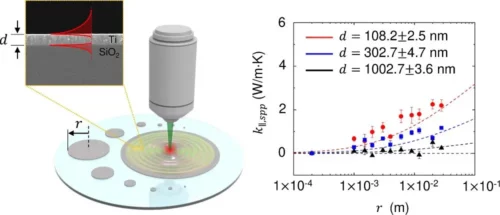Researchers at the Korea Advanced Institute of Science and Technology have developed a new heat transfer mode using surface plasmon polaritons that boosts heat dispersion by 25% in semiconductors.

The need to reduce the dimensions of semiconductors and the challenge of effectively dissipating heat generated at device hotspots has adversely affected the reliability and longevity of current devices. Current thermal management technologies need to improve in addressing this issue. Consequently, the emergence of a novel approach utilizing surface waves generated on thin metal films placed over the substrate represents a significant breakthrough in heat dispersion.
Researchers at the Korea Advanced Institute of Science and Technology (KAIST) have successfully measured a previously unobserved heat transfer phenomenon caused by ‘surface plasmon polariton’ (SPP) in a thin metal film deposited on a substrate, marking a world-first accomplishment. SPP is a surface wave that arises on the metal surface due to the intense interaction between the electromagnetic field at the interface of the metal and dielectric and the collective oscillations of the free electrons present on the metal surface and other similarly vibrating particles.
The research team harnessed the potential of SPP, surface waves generated at the interface between a metal and dielectric, to enhance thermal diffusion in nanoscale thin metal films. This novel heat transfer mechanism is advantageous for device manufacturing, as it can be effectively implemented over a wide area when a thin metal film is deposited onto a substrate. Notably, the research team successfully demonstrated a significant 25% increase in thermal conductivity by employing surface waves on a 100-nanometer-thick titanium (Ti) film with a radius of approximately 3 cm.
The researchers believe that the research unveils a previously unidentified heat transfer mode utilizing surface waves on a thin metal film deposited on a substrate, with the added advantage of low processing complexity. This pioneering development can serve as a nanoscale heat spreader, effectively dissipating heat close to hotspots in semiconductor devices prone to overheating.
The outcome carries significant implications for advancing high-performance semiconductor devices, as it enables the quick dissipation of heat in nanoscale thin films. This newly identified heat transfer mode, pioneered by the research team, is anticipated to address the fundamental challenge of thermal management in semiconductor devices. Notably, it allows for enhanced heat transfer even in nanoscale thickness, overcoming the typical decrease in thermal conductivity caused by boundary scattering effects.
Reference: “Boosting Thermal Conductivity by Surface Plasmon Polaritons Propagating along a Thin Ti Film” by Dong-min Kim, Sinwoo Choi, Jungwan Cho, Mikyung Lim and Bong Jae Lee, 26 April 2023, Physical Review Letters.
DOI: 10.1103/PhysRevLett.130.176302






